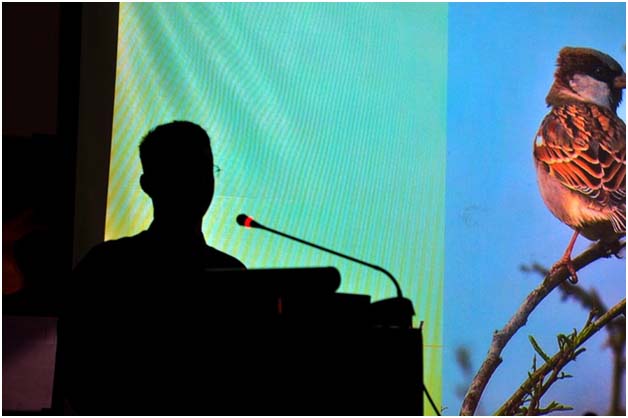‘Poor indeed is the garden in which birds find no home’ - Abram L. Urban
A public discussion was organized by Toxics Link in an attempt to understand the question of disappearing sparrows of Delhi at the India International Centre, New Delhi on May 8, 2012. The event encompassed a film screening and a panel discussion moderated by Ravi Aggarwal, Director, Toxic Links. While experts discussed the reasons for the decline, the key question was whether the 'loss' of sparrows and other birds we once took for granted, is a sign of other changes in our environment?
Beyond the mirage - A film by Nutan Manmohan
The film “Beyond the mirage” directed by Nutan Manmohan, (produced by PSBT), examined the ensuing battle for food and habitat in Delhi among the small and big birds that throng the city. It also documents the predicament of smaller birds, like sparrows, which are fast loosing this war against bigger predators. The house sparrow, once the exemplar of a commonplace bird, is not so common any longer in cities like Delhi. Once chirping happily in our backyards, the sparrows are hardly noticeable these days unlike some other birds such as pigeons that are seen in plenty.
The film depicts how 25 per cent of birds in India have gone extinct since 2008 because of lack of nesting places and loss of micro eco-systems. It shows how the significance of sparrows’ has been undermined without realising that the survival of big exotic birds is dependent on the presence of small birds like sparrows. The increase in the population of dogs and scavengers like crows and kites due to the feed that they receive from urban people is detrimental to the house sparrow. It documents the consequences that this has for small birds such as sparrows, which are fast losing this war against bigger predators. Dogs scare the birds away while crows, being very aggressive end up eating the sparrows’ eggs.

Panelists: Dr. Koustubh Sharma, Dr. Neeraj Khera and Dr. Surya Prakash
Image courtesy: ToxicsLinks
Dr Surya Prakash who specializes in Zoology at School of Life Sciences in Jawaharlal Nehru University and is a passionate bird watcher, charted a steep decline in the population of sparrows and held human beings responsible for the disappearance of sparrows. During the past 25 years, the sparrow population in the country has plummeted by 50 per cent. The decline in the state of Andhra Pradesh is highest at around 80 per cent, mirroring severe decline in numbers of the bird across the other states.
“House sparrows live in groups and feed on grains, insects, kitchen scrap and flower buds. They prefer thatched houses and bungalows to concrete structures such as flats to build their nests. They lay 3-5 eggs at a time barring no season.” (Deccan Herald, 2004)
There has been a remarkable decline and the worry is that their population will crash down to a level where it is no longer sustainable.
Changing human lifestyles, climate change, loss of micro habitats (wetland bird areas, shrub vegetation etc.,), architectural changes leading to decreasing spots to lay eggs, changes in agricultural patterns, proliferation of predator birds, microwave towers, excessive use of pesticides are some of the human induced changes that have led to a decrease in the population of sparrows, according to Prakash. Our homes and buildings these days do not have ventilators to leave enough space to the sparrows to build their nests, he said. The scarcity of insects and grains which serve as protein supplements for the young ones of sparrows is a major cause of their decline.
Dr. Koustubh Sharma, Senior Regional Ecologist-Snow Leopard Trust and Co-investigator, BNHS-Citizen Sparrow Project discussed how formerly, miners used to carry canaries down into the mines with them. If the canaries showed signs of distress it indicated that there were poisonous gases in the air, and the miners would immediately leave the mine.

Dr. Koustubh Sharma, BNHS-Citizen Sparrow Project
Image courtesy: ToxicsLinks
Like snow leopards which are considered indicators of climate and environmental changes at higher altitudes, sparrows, a star species are indicators of such changes in the urban ecosystem. Hence they can be regarded as the snow leopard of the urban ecosystem, noted Sharma. So, if sparrows of Delhi are dwindling it could be warning to its residents. Either air pollution levels could be rising dangerously or the grains could be containing alarming dosages of pesticides. Indeed sparrows can be used as bio-monitors to detect urban metal pollution.
Because of lack of research and understanding, the reasons for the vanishing of sparrows are still unknown. We still lack a large scale systematic community that pools in information on species, he noted.
Sensitising citizens for protecting sparrows, Sharma highlighted the Citizen Sparrow Project that aims at creating a constituency for sparrows among the citizens in India. A joint initiative by the Bombay Natural History Society and Ministry of Environment and Forests, the project invited inputs from citizens on the sightings of sparrows and has received a good response - 7461 contributions from 4701 people at 6019 locations in India. It will ultimately help in estimating the cause of decline of sparrow population, he added.
According to Neeraj Khera, Technical Expert – Deutsche Gesellschaft für Internationale Zusammenarbeit (GIZ) “since sparrows are sensitive to changes in the environment, they serve as an important bio-indicator for a healthy urban ecosystem, indirectly indicating human health, and their decline today has started resulting in increasing diseases among the people”.
People in urban areas are often seen feeding grains to rock pigeons. Due to availability of enough food there has been an over-explosion of their population. These pigeons are now occupying the nesting spaces of sparrows, as a result of which the sparrow population has drastically reduced in urban areas in the country. The growing numbers of rock pigeons has created an imbalance among the species and they now dominate the bird population, according to Khera.

The chirpy sounds made by these small birds are rarely heard today
Image courtesy: www.garthright.blogspot.com
Delhi has 15,000-20,000 green spaces today, but because of their smaller sizes, these are unable to support larger habitat diversity and provide ecological services. Inter-connecting of such small patches is needed to reintroduce the lost habitat, she said. Because sparrows have not declined below the threshold limit in Delhi, we can still afford to bring them back through proper conservation practices.
Due to decrease in numbers, a bird as common as the sparrow was included by the IUCN in its Red Data List of threatened species in 2002 alongside the glamorous snow leopard, tiger and red panda.
The discussion suggested that awareness can be raised regarding the plight of the sparrow and sites earmarked as safe havens for the birds. To hear the chirping again people can take small steps such as placing wooden or earthen homes, feeding them, putting water pots for them, planting trees and discouraging use of pesticides.
Bird lovers in Mumbai are providing shelters like wooden boxes on trees, which can be used as nests by sparrows. Sanctuaries too can be created across urban spaces to help save the dwindling population of house sparrows.